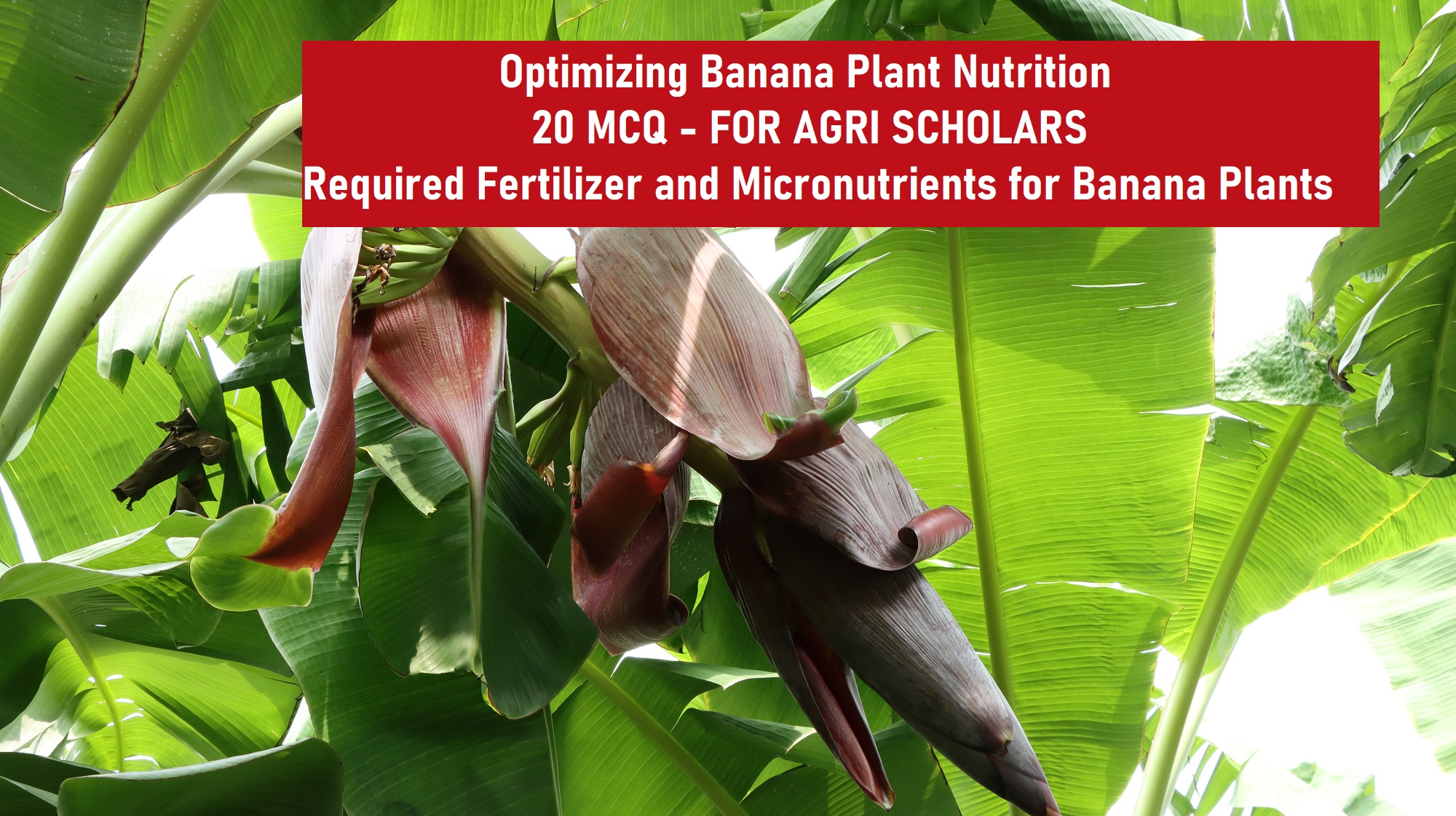Optimizing Banana Plant Nutrition - 20 MCQ for Scholars - Required Fertilizer and Micronutrients for Banana Plants
Banana plants, like many crops, have specific nutritional requirements crucial for optimal growth and fruit production. Macronutrients such as nitrogen, potassium, and phosphorus play pivotal roles in vegetative growth, flower and fruit development, and root establishment. Micronutrients such as manganese, boron, and zinc are equally essential, preventing issues like leaf yellowing, little leaf syndrome, and black streaks on fruit. Calcium ensures structural integrity, magnesium aids in chlorophyll synthesis, and copper activates enzymes vital for metabolic processes. Proper application of fertilizers, with recommended N-P-K ratios and regularity, is fundamental, addressing deficiencies that may lead to fruit splitting or bronzing of leaves. Soil pH maintenance within the range of 5.5-6.5 is also critical for nutrient availability. Recognizing and addressing nutrient deficiencies in banana plants is essential for cultivating healthy, productive crops.
1. What is the primary macronutrient essential for banana plant growth?
a) Calcium
b) Nitrogen
c) Iron
d) Zinc
Answer: b) Nitrogen
Explanation: Nitrogen is a crucial macronutrient for banana plants as it promotes vegetative growth, leaf development, and overall plant vigor.
2. Which micronutrient is essential for the prevention of yellowing in banana plant leaves?
a) Manganese
b) Boron
c) Copper
d) Magnesium
Answer: a) Manganese
Explanation: Manganese is important for chlorophyll synthesis, preventing yellowing or interveinal chlorosis in banana leaves.
3. What is the primary function of potassium in banana plants?
a) Root development
b) Flower and fruit development
c) Photosynthesis
d) Disease resistance
Answer: b) Flower and fruit development
Explanation: Potassium is crucial for flower and fruit development in banana plants, contributing to quality and yield.
4. Which fertilizer component is essential for the structural integrity of banana plant cell walls?
a) Phosphorus
b) Calcium
c) Sulfur
d) Iron
Answer: b) Calcium
Explanation: Calcium is essential for cell wall structure, preventing disorders like tip burn in banana plants.
5. In banana cultivation, what deficiency symptom is associated with insufficient magnesium?
a) Leaf curling
b) Fruit drop
c) Yellowing between veins
d) Stunted growth
Answer: c) Yellowing between veins
Explanation: Magnesium deficiency causes interveinal chlorosis in banana leaves, affecting chlorophyll production.
6. What is the primary role of phosphorus in banana plants?
a) Flower and fruit development
b) Root development
c) Photosynthesis
d) Disease resistance
Answer: b) Root development
Explanation: Phosphorus is crucial for root development and overall plant energy transfer in banana plants.
7. Which micronutrient deficiency causes a condition known as "little leaf" in banana plants?
a) Boron
b) Zinc
c) Manganese
d) Copper
Answer: a) Boron
Explanation: Boron deficiency leads to the "little leaf" symptom, characterized by small, distorted leaves in banana plants.
8. What is the recommended nitrogen-phosphorus-potassium (N-P-K) ratio for banana plants during the fruiting stage?
a) 10-10-10
b) 20-10-10
c) 8-3-9
d) 15-5-20
Answer: c) 8-3-9
Explanation: The 8-3-9 N-P-K ratio is commonly recommended for banana plants during the fruiting stage.
9. Which nutrient is crucial for the activation of enzymes involved in photosynthesis in banana plants?
a) Iron
b) Magnesium
c) Potassium
d) Manganese
Answer: a) Iron
Explanation: Iron is essential for the activation of enzymes involved in photosynthesis, ensuring optimal plant growth.
10. What is the primary function of sulfur in banana plants?
a) Flower and fruit development
b) Protein synthesis
c) Root development
d) Chlorophyll production
Answer: b) Protein synthesis
Explanation: Sulfur is important for protein synthesis, contributing to overall plant growth and development.
11. Which nutrient deficiency is associated with the development of "bronzing" symptoms on banana leaves?
a) Zinc
b) Boron
c) Manganese
d) Copper
Answer: a) Zinc
Explanation: Zinc deficiency can lead to bronzing or reddish discoloration of banana leaves.
12. What is the recommended frequency for applying fertilizer to banana plants during the growing season?
a) Monthly
b) Weekly
c) Bi-weekly
d) Annually
Answer: c) Bi-weekly
Explanation: Fertilizer is often applied every two weeks during the growing season to meet the nutrient demands of banana plants.
13. Which nutrient deficiency is associated with the development of "black streak" symptoms on banana fruit?
a) Copper
b) Iron
c) Boron
d) Magnesium
Answer: c) Boron
Explanation: Boron deficiency can result in the development of black streaks on banana fruit.
14. What is the primary function of copper in banana plants?
a) Flower and fruit development
b) Root development
c) Photosynthesis
d) Enzyme activation
Answer: d) Enzyme activation
Explanation: Copper is essential for the activation of enzymes involved in various metabolic processes in banana plants.
15. What role does magnesium play in banana plants?
a) Chlorophyll synthesis
b) Disease resistance
c) Flower and fruit development
d) Root development
Answer: a) Chlorophyll synthesis
Explanation: Magnesium is crucial for chlorophyll synthesis, contributing to the green color of leaves in banana plants.
16. Which nutrient deficiency is associated with the development of "yellow mottle" symptoms on banana leaves?
a) Iron
b) Manganese
c) Zinc
d) Potassium
Answer: b) Manganese
Explanation: Manganese deficiency can lead to the development of yellow mottling or streaking on banana leaves.
17. What is the primary function of nitrogen in banana plants?
a) Flower and fruit development
b) Root development
c) Photosynthesis
d) Disease resistance
Answer: c) Photosynthesis
Explanation: Nitrogen is essential for chlorophyll production and overall photosynthesis in banana plants.
18. Which macronutrient deficiency is associated with the development of "fruit splitting" in bananas?
a) Potassium
b) Phosphorus
c) Nitrogen
d) Calcium
Answer: d) Calcium
Explanation: Calcium deficiency can lead to fruit splitting in banana plants, affecting fruit quality.
19. What is the recommended pH range for soil in banana cultivation?
a) 4.0-5.0
b) 5.5-6.5
c) 7.0-8.0
d) 9.0-10.0
Answer: b) 5.5-6.5
Explanation: The ideal soil pH range for banana cultivation is generally between 5.5 and 6.5.
20. Which micronutrient is crucial for the formation of banana flowers and fruits?
a) Boron
b) Copper
c) Manganese
d) Zinc
Answer: a) Boron
Explanation: Boron is essential for flower and fruit development in banana plants, influencing pollen germination and fruit setting.

